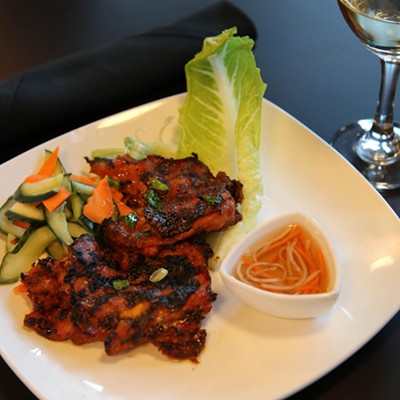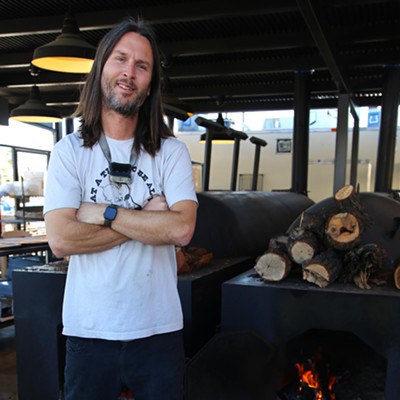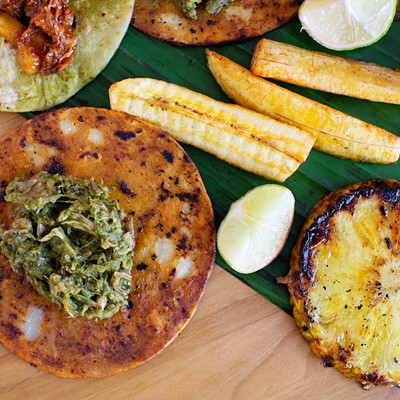They make in Haute Lorraine ...
--From "A Cider Song," by G.K. Chesterton (1874-1936)
I return to the subject of wine, an area in which I have wide experience and only semi-skilled pretensions. On the desk beside me is a newly discovered favorite--7 Deadly Zins (Lodi Appellation, 2003)--created from an old-vine blend of Schulenberg, Snyde, Maley and Bishofberger, Lauchland, Manion and Ferrero stock. Its labeling promises that the tipping of a glass allows the sipper to also imbibe fairer vinous forms of greed, pride, lust, gluttony, anger, sloth and envy. Taken in sufficient amounts, I know that any wine will encourage the same, or some combination thereof; in moderation and after breathing a bit, 7 Deadly Zins is rich and well-rounded.
I bought it, honestly, because the bottle's label tickled my fancy before I knew its contents would do the same to my palate. One of Tucson's Hottest Chefs recently told me he thought it a pretty decent wine, too, and I now keep a couple of bottles around. But it made me think about labels again, and the power of attraction and association they hold.
At the farm, in the pantry behind the old summer kitchen, there's a shelf on which rests empty bottles filled with memories like a line of journals. I see them in my mind: A Mt. Ambelos from Greece by way of a restaurant on Halsted, where we danced with waiters after a day's work at the Newberry Library in Chicago; a Zellerbach Merlot from a distant Thanksgiving at the vineyard; a scarred and tattered Lafite '62, from a wine cave high in the Rockies, consumed in a dinner of laughter and love on a grassy lawn beside the perfection of Born Lake; a Margaux that was one of two fueling a trip on the bullet train out of Paris; a new green wine from Germany; and an amazing Shiraz from dinner one night after watching the penguins come home at dusk on Phillips Island. And each of those images have film strips that unwind--the oracles in Bughouse Square outside the library; the oversized jar of marinated vegetables, pickled by Carol Channing herself, that had to be avoided in that Colorado cave; unpleasant tourists on the trains; a scary cellar in Munich and the rich Orthodoxy of Caulfield in Melbourne.
When the Old Pueblo Club made its ill-fated move to the top of the Williams Center, Mr. Sfarnis had a motley collection of great single-bottles he chose not to move but to sell to me. For a while, I kept them in the old root cellar of our house on Franklin Street, then moved them to a too-precious wine-storage shop at Crossroads. Some of them ended up in the pantry, too: now-dusty Veuve Cliquots, Cabs and Pinots from the '70s, once-crisp Chards that had turned but which I used to make one-of-a-kind dressings.
Here in the desert, I keep more recent souvenirs: a Ravens Wood Cab '97 that we had at my goddaughter's wedding high above the Mississippi; a single symbolic empty Gevrey-Chambertin, my wine-of-choice for life-passage times; a Carmel from pre-Intifada days in Israel; an '85 Rioja, had on a starry night in Sevilla's Placa Santa Cruz, celebrating survival. All empty, but not sadly.
Friends in the biz keep me pointed in the right direction by suggesting newer offerings. There is no better resource than a knowledgeable waiter or proprietor. Tucson has some of the best. So, I also have a small rack that holds a classically labeled Shiraz-Malbec (Donas Paula) and Schug Carneros Pinot Noir, a beautifully wreathed Napa Valley Cab from Chateau Potelle, an appropriately florid Fleur Pinot and galactically labelled Sangiovese from Valley of the Moon, various Pinot Grigios and faithful standbys of Glen Ellen for cooking and whenever.
There are other labels, other bottles of memory, ranging from an amazing 18-year-old Glen Carioch single-malt found in Anchorage to my favorite, which is in my keeping but not my ownership. "Watergate Blended Scotch, A Legend Since 1946, Distilled and Bottled under White House Supervision," has on its label a defiant picture of Richard Milhous What's-His-Name, and the promise that "The Proof Increases Every Day." I keep looking for the Texas equivalent in bourbon.
Some of these aides-memoires purposely mark not-so-good times, and they are important, too. But I keep them tucked in the back--here and in the farm pantry. And I try to never acquire those labels a second time. What's in the glass is important; what lasts is everything associated with it.
I started with a fave quote, and I end with one that always makes me smile:
OH, for a bowl of fat Canary,
Rich Palermo, sparkling Sherry,
Some nectar else, from Juno's dairy;
Oh, these draughts would make us merry!
--"Oh for a Bowl of Fat Canary," by John Lyly (1554-1606)
Lyly goes on to discuss wenches and such, but you get the drift.








